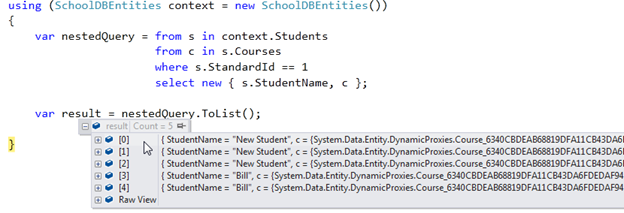EntityFramework 学习 一 Entity Framework 查询设计
First/FirstOrDefault:
using (var ctx = new SchoolDBEntities()) { var student = (from s in ctx.Students where s.StudentName == "Student1" select s).FirstOrDefault<Student>(); }
对应的sql语句如下
SELECT TOP (1) [Extent1].[StudentID] AS [StudentID], [Extent1].[StudentName] AS [StudentName], [Extent1].[StandardId] AS [StandardId] FROM [dbo].[Student] AS [Extent1] WHERE 'Student1' = [Extent1].[StudentName]
如果没有数据First()将抛出异常,而FirstOrDefault()则返回数据类型的默认值,如引用类型则返回null
Single/SingleOrDefault:
using (var ctx = new SchoolDBEntities()) { var student = (from s in context.Students where s.StudentID == 1 select s).SingleOrDefault<Student>(); }
sql语句如下
SELECT TOP (2) [Extent1].[StudentID] AS [StudentID], [Extent1].[StudentName] AS [StudentName], [Extent1].[StandardId] AS [StandardId] FROM [dbo].[Student] AS [Extent1] WHERE 1 = [Extent1].[StudentID] go
如果返回的结果包含一个以上的元素时,两者都会抛出异常,使用Single可以确定返回结果是否只有一个元素
ToList:
using (var ctx = new SchoolDBEntities()) { var studentList = (from s in ctx.Students where s.StudentName == "Student1" select s).ToList<Student>(); }
SELECT [Extent1].[StudentID] AS [StudentID], [Extent1].[StudentName] AS [StudentName], [Extent1].[StandardId] AS [StandardId] FROM [dbo].[Student] AS [Extent1] WHERE 'Student1' = [Extent1].[StudentName] go
GroupBy:
using (var ctx = new SchoolDBEntities()) { var students = from s in ctx.Students group s by s.StandardId into studentsByStandard select studentsByStandard; }
sql语句如下
SELECT [Project2].[C1] AS [C1], [Project2].[StandardId] AS [StandardId], [Project2].[C2] AS [C2], [Project2].[StudentID] AS [StudentID], [Project2].[StudentName] AS [StudentName], [Project2].[StandardId1] AS [StandardId1] FROM ( SELECT [Distinct1].[StandardId] AS [StandardId], 1 AS [C1], [Extent2].[StudentID] AS [StudentID], [Extent2].[StudentName] AS [StudentName], [Extent2].[StandardId] AS [StandardId1], CASE WHEN ([Extent2].[StudentID] IS NULL) THEN CAST(NULL AS int) ELSE 1 END AS [C2] FROM (SELECT DISTINCT [Extent1].[StandardId] AS [StandardId] FROM [dbo].[Student] AS [Extent1] ) AS [Distinct1] LEFT OUTER JOIN [dbo].[Student] AS [Extent2] ON ([Distinct1].[StandardId] = [Extent2].[StandardId]) OR (([Distinct1].[StandardId] IS NULL) AND ([Extent2].[StandardId] IS NULL)) ) AS [Project2] ORDER BY [Project2].[StandardId] ASC, [Project2].[C2] ASC go
OrderBy:
using (var ctx = new SchoolDBEntities()) { var student1 = from s in ctx.Students orderby s.StudentName ascending select s; }
SELECT [Extent1].[StudentID] AS [StudentID], [Extent1].[StudentName] AS [StudentName], [Extent1].[StandardId] AS [StandardId] FROM [dbo].[Student] AS [Extent1] ORDER BY [Extent1].[StudentName] ASC go
Anonymous Class result:
using (var ctx = new SchoolDBEntities()) { var projectionResult = from s in ctx.Students where s.StudentName == "Student1" select new { s.StudentName, s.Standard.StandardName, s.Courses }; }
SELECT [Extent1].[StudentID] AS [StudentID], [Extent1].[StudentName] AS [StudentName], [Extent2].[City] AS [City] FROM [dbo].[Student] AS [Extent1] LEFT OUTER JOIN [dbo].[StudentAddress] AS [Extent2] ON [Extent1].[StudentID] = [Extent2].[StudentID] WHERE 1 = [Extent1].[StandardId] go
Nested queries:嵌套查询

sql语句
SELECT [Extent1].[StudentID] AS [StudentID], [Extent1].[StudentName] AS [StudentName], [Join1].[CourseId1] AS [CourseId], [Join1].[CourseName] AS [CourseName], [Join1].[Location] AS [Location], [Join1].[TeacherId] AS [TeacherId] FROM [dbo].[Student] AS [Extent1] INNER JOIN (SELECT [Extent2].[StudentId] AS [StudentId], [Extent3].[CourseId] AS [CourseId1], [Extent3].[CourseName] AS [CourseName], [Extent3].[Location] AS [Location], [Extent3].[TeacherId] AS [TeacherId] FROM [dbo].[StudentCourse] AS [Extent2] INNER JOIN [dbo].[Course] AS [Extent3] ON [Extent3].[CourseId] = [Extent2].[CourseId] ) AS [Join1] ON [Extent1].[StudentID] = [Join1].[StudentId] WHERE 1 = [Extent1].[StandardId] go




